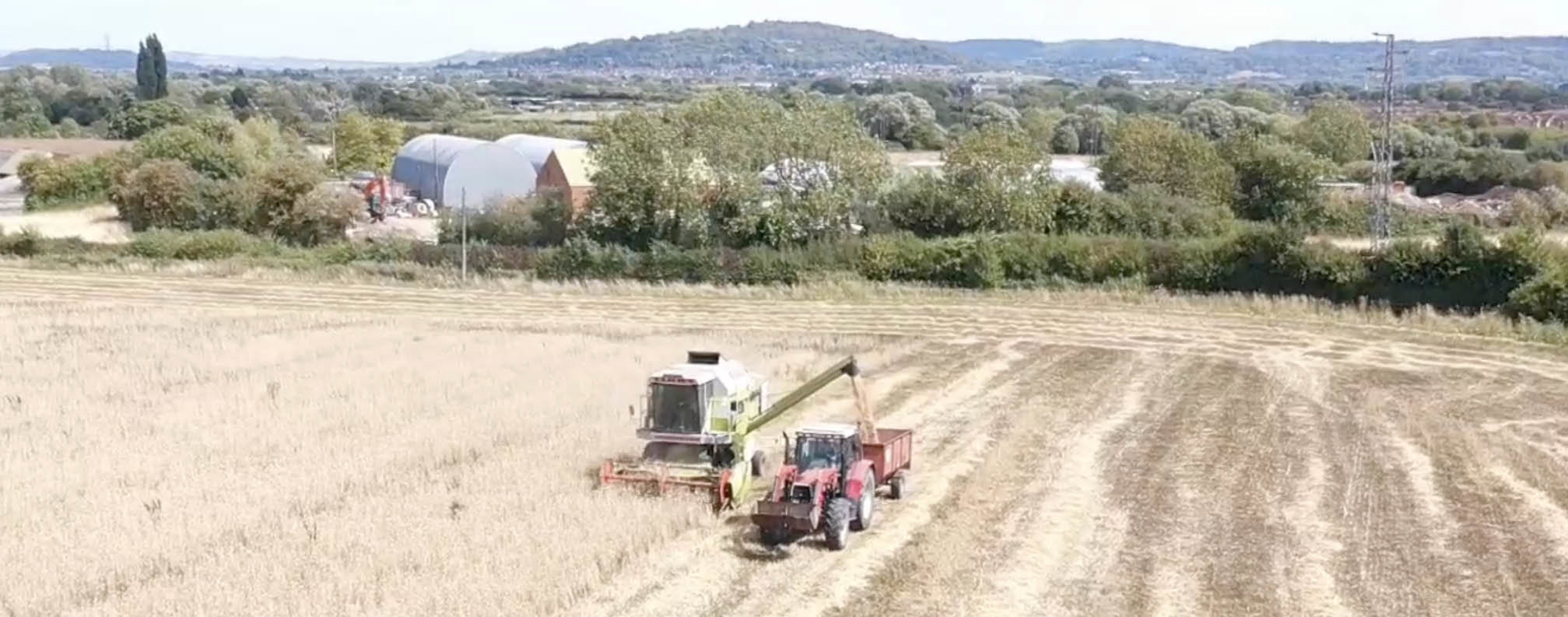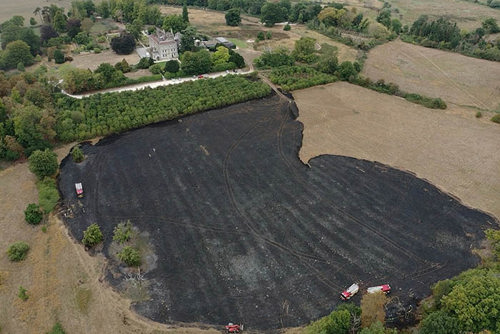The Art of Noticing ~ August

2nd August – The calls of buzzards are an ever-present sound on the Elmore Estate. Their feathers litter the fields, and they are a reliable and reassuring sight to be seen sitting in the trees and soaring on the thermals overhead.
They have a distinctive cry and cut a familiar silhouette in the skies. Their fanned tail, dark wing edges and finger like wing tips make them easily identifiable, even for those new to bird watching such as myself. The common buzzard is just that, the most prolific bird of prey to be found in the UK. A large bird with an adult wingspan of 1.1 – 1.4m, their size and shape makes them easy to spot in flight.
They soar over field, woodland and motorways alike searching for prey, which is mostly rabbits, smaller birds and rodents, as well as carrion. They have a green conservation status which means that neither their numbers or habitat is currently facing a threat.
Meanwhile, a smaller and rarer sighting on the Elmore Estate is the clouded yellow butterfly. A true migration butterfly that escapes the heat of Europe and North Africa in the summer, then returns in winter to avoid the cold winters here in the UK. They are a rare sighting and is the first time we have seen it here at Elmore.

5th August - Our wild swimming lake has been busy with swimmers for the last few weeks making the most of the warm water temperatures and the even hotter summer. It’s a stunning corner of the Estate where you can truly immerse yourself in stillness and feel refreshed and rested.
When swimming through the water you will notice comparatively warmer and cooler pockets of water. Our guests always query this phenomena, and it comes down to a few different factors.
Differences in water depth will affect how much the sunlight can warm the water, wind direction and water turbulence can mix water layers, the coverage of pond weed will act to insulate some area and lastly the incoming water from the underwater spring will feed cooler water into one area of the pool but not the other.
7th August – Our resident kingfisher sunbathes on the jetty. It's been around a month since I last spotted him and to see him is always a beautiful and welcome sight. The speed that a kingfisher hunts can make them tricky to spot, however their striking blue and orange plumage makes him instantly identifiable. They fly very fast and low over the surface to hunt. In Madams Pool, swimming below the surface, there are numerous rudd, a ready and waiting meal.
Kingfisher are sensitive to very cold winters and habitat degradation due to pollution and poor watercourse management. Due to this they are offered addition protection under the Wildlife and Countryside Act. Fortunately, the reeds surrounding the pond keeps the water clean and provide a stable habitat for our kingfisher.
9th August – Today, we worked around the busy schedule of the combine harvester. We received word this morning that it would be available in the afternoon, and with the wheat ready, we set to work on the two small fields. Although the land on the Estate is primarily focused on rewilding, we still maintain these crop fields so that the flour produced can be used in the kitchens at the court to bake bread for weddings. The fields are planted with a mix of wheat and clover. The clover, which naturally fixes nitrogen in the soil, can make the crop appear a little sparse at times, but it is invaluable for maintaining the health and fertility of the land.
13th August – An old ash tree stands proudly at the edge of a small woodland called Ash Covert. Its centre is hollow, and there are tell-tale signs that it is visited by a barn owl. Owl pellets litter the floor at the trees base along with the occasional down feather.
It was a tricky place to set up a trail camera, so I created a kind of tripod structure that I drove into the hard soil so keep it stable for days at a time. I set up the camera pointing up at the hole in the tree and waited. After only a few days I grew too impatient to see if it had captured anything, confidently expecting to be let down. Quite the opposite.
Video after video of two beautiful barn owls can be seen very close up hopping in and out of the tree, grooming themselves, stretching their wings and snoozing. I even caught a clip at night of one owl comically startling the other by suddenly popping out of the owl hole and the other leaping back on its branch flapping its wings in obvious surprise.
The barn owl is a common owl in the UK. It is white with creamier areas on its back and a classic round face disc. Barn owls are poorly monitored due to being nocturnal and it is illegal to intentionally or recklessly disturb them. So, while I will continue to monitor them at Elmore I will endeavour to do so with as little disruption as possible. These sightings should be treasured and protected.

14th August – Besides the track that leads to our wild swimming pond, eagle eyed guests who look to their left will see a huge oak tree. Its trunk is thick, and its canopy is very wide. It will be home to untold numbers of invertebrates, birds, mammals, fungi, lichen and plants. It is a living skyscraper of biodiversity.
While reading I came across a few methods of aging trees that doesn’t include taking a core and counting its rings, this is far less intrusive. All the methods start by measuring the circumference of the truck at about chest height, ours measured 460cm. From here you can calculate the trees ages depending on the growth rate for that species of tree and the location of the tree. I concluded this this tree is around 275 years old! This ancient oak was an acorn in 1750. When an oak has reached this age, it's in what ecologists call the 'veteran' stage.
Elmore Estate was owned by Sir John Guise the 4th baronet when this oak started its life. This veteran oak has seen the whole industrial revolution. It has seen us discover how to destroy our environment; now we must hope that the next thing it lives through is a time when we learn from our errors and undo the damage we have caused.
19th August – The ground is littered with abnormal, mutated acorn-like growths. These are oak galls and are formed when a small wasp lays its eggs in the acorn in early summer. As the larvae develop a chemical reaction is triggered that forms the knobbly galls. The wasps will develop in the oak galls all winter before emerging the following spring. Oak trees, it seems, support a staggering number of species.
23rd August – The fields are brown and crisp. There has been no meaningful rain for months. We wanted to document these unprecedented dry conditions so got the drone out to do a fly over of the land. While the drone was out a curious patch of dust or smoke can be seen in the distance. Flying the drone closer the panic sets in, a field is on fire!
The team calls in the fire brigade and six fire engines arrive. They fight the fire along with the farm manager who manages to smother large patches with the bucket of the telehandler. Team E works cohesively and efficiently to direct the emergency services. All people and livestock are unharmed.
Despite controlling the fire, it starts up again later that night and is handled quickly by the emergency services once again. All in all, 6-8 acres were affected and the general damage to infrastructure has been contained. We were lucky this time. But it forces the consequences of our changing climate into the forefront of our minds. Wild fires, once unthought of during your traditional wet English summer, are now here, with tinder dry fields and becoming more frequent across the country! Climate change is making itself known. It is not a distant concept. It will affect us all if given the chance and next time the consequences might be worse.

29th August – As the summer has progressed the water level in our wild swimming pond has been getting lower. The prolonged period of little to no rain has caused more of the ponds shores to reveal themselves on which I discovered a large shell. This shell was identified as a freshwater swan mussel.
Swan mussels are a large freshwater bivalve mollusc and burrow into the soft silty bottom of a pond to filter feed. As the name suggests swan mussels will actually filter the water that passes through them as they feed, thus contributing to a cleaner and more biodiverse pond.
Although our monthly water quality testing always comes back as safe and clean, it is interesting to know that we owe this in part to the swan mussel hidden in its depths.
It just reinforces the knowledge that when you let nature lead the way, nature will always create balance.
by Hazel Alabaster, Elmore Estate Ranger


